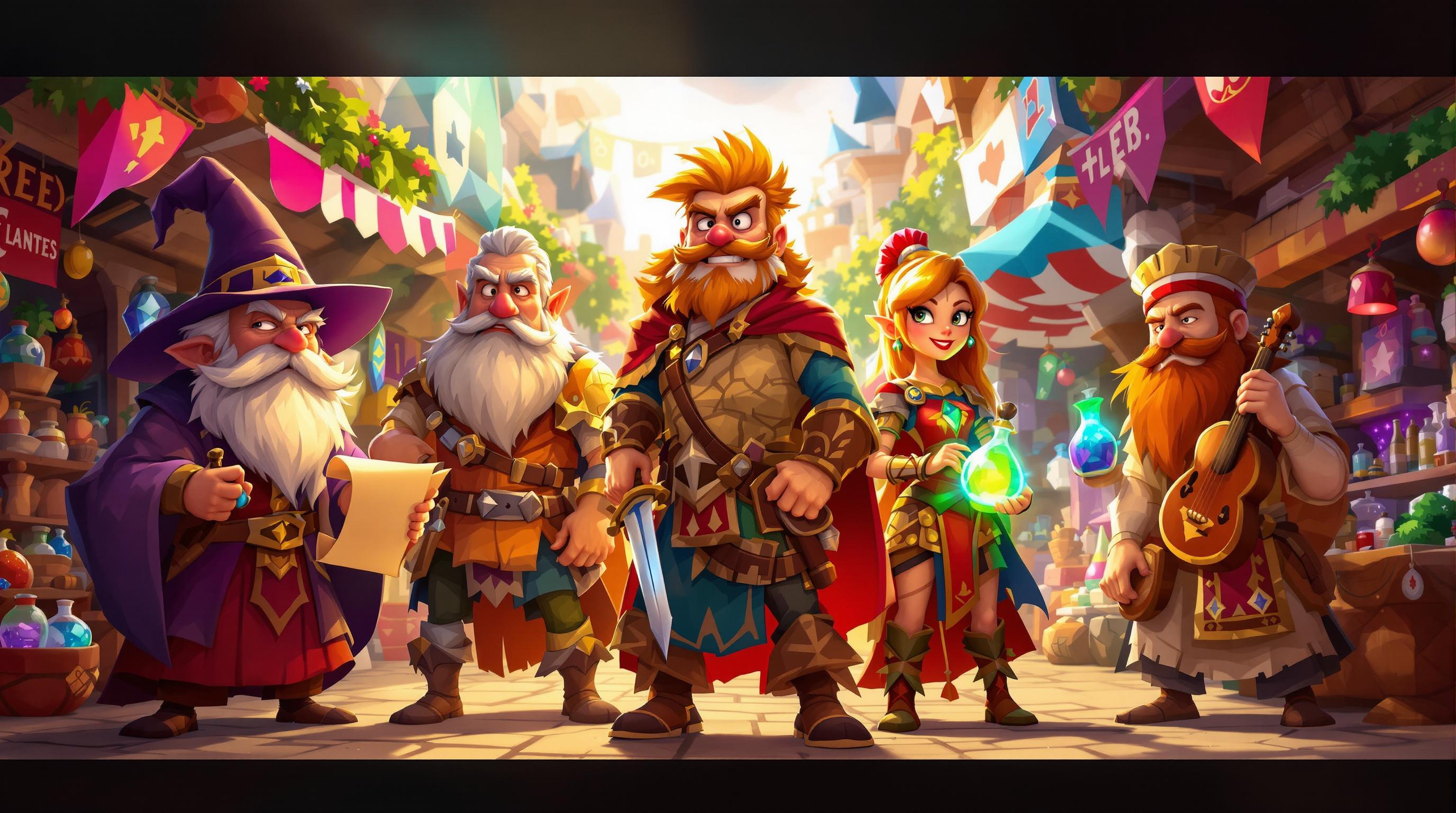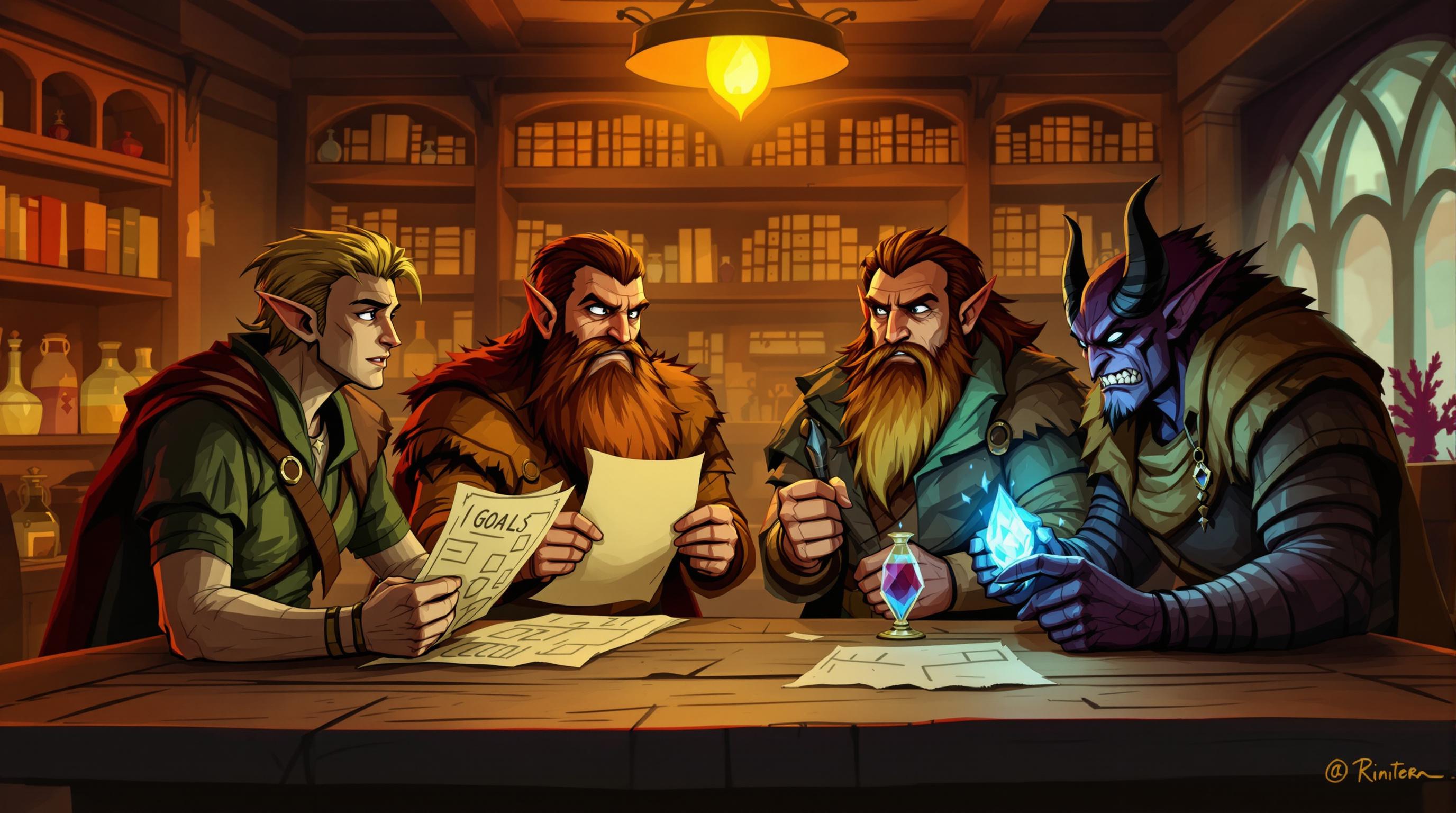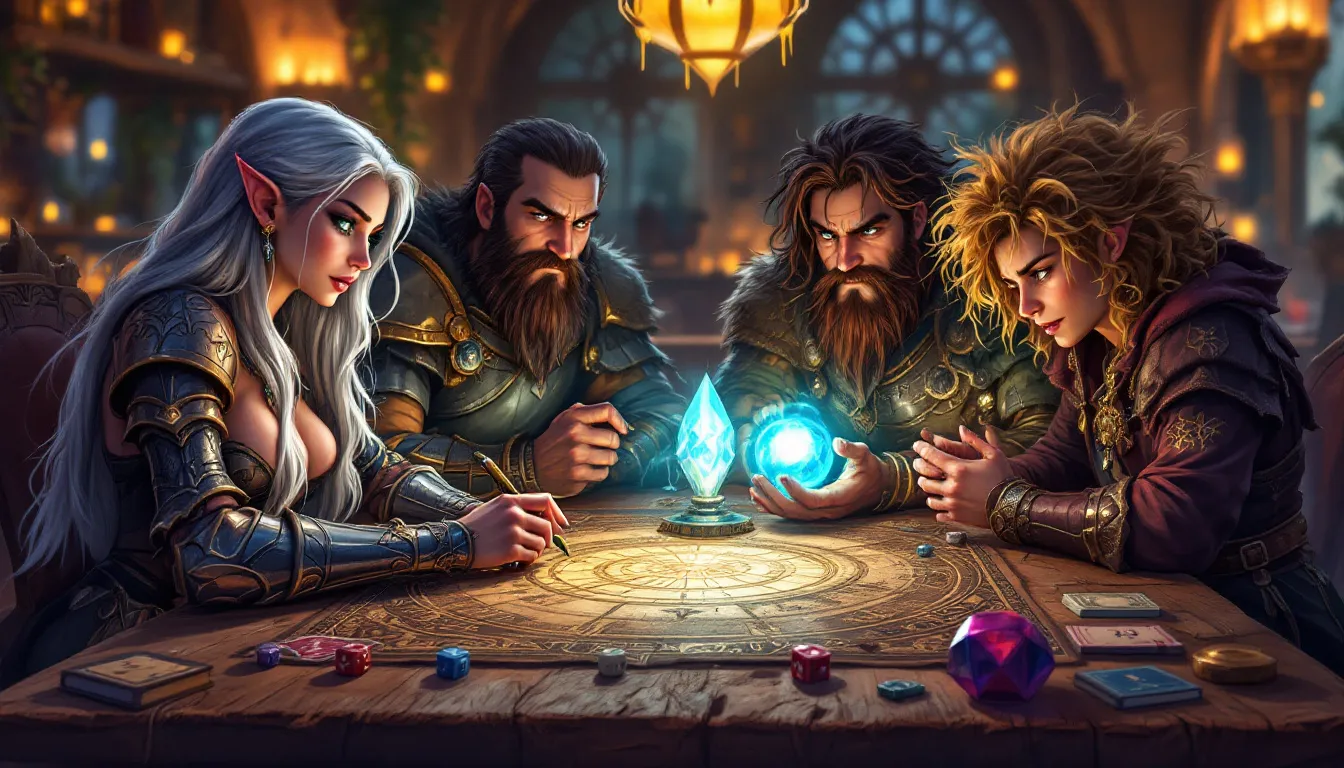Want to create engaging puzzles for your RPG? Here’s a quick guide to crafting object-based puzzles that challenge players and enhance your story.
Key Steps:
- Plan Puzzle Mechanics: Choose objects (mirrors, runes, levers) and design logical, multi-step challenges.
- Make It Player-Friendly: Add clear clues, interactive elements, and consistent feedback to guide players.
- Tie It to the Story: Ensure puzzles fit the setting (e.g., ancient ruins or magical towers) and reveal plot or lore.
- Test and Adjust: Test with different players, balance difficulty, and refine for smooth gameplay.
Quick Tips:
- Use visual, sound, or environmental feedback to help players without giving away solutions.
- Align puzzles with the game world and narrative for deeper immersion.
- Start simple, then increase complexity as players progress.
Follow these steps to design puzzles that are fun, intuitive, and story-driven!
Making D&D / TTRPG puzzles more immersive (tips and examples)
Step 1: Plan the Puzzle's Mechanics
Creating engaging puzzle mechanics involves thinking about how different elements interact and challenge players in meaningful ways.
Choose Key Puzzle Elements
Start by selecting the core objects for your puzzle. These could be physical tools like mirrors or levers, magical items such as runes or artifacts, or elements from the environment like light sources or flowing water. Make sure these objects fit naturally within the game's story and setting to enhance immersion. They should also align with the game mechanics, have a clear purpose, and feel logical in the context of the world.
Add Logical Challenges
Introduce obstacles that make the puzzle more engaging. For example, a simple light-redirecting puzzle becomes much more interesting if you add walls that block direct paths, forcing players to think creatively about alternative solutions [1].
| Challenge Type | Example Application |
|---|---|
| Environmental Hazards | Rising water levels that require quick thinking |
| Hidden Components | Switches concealed and revealed through exploration |
| Sequential Triggers | Pressure plates that must be activated in a specific order |
Create Multi-Step Solutions
Design puzzles with multiple layers, where solving one part leads to another challenge. This keeps players invested and provides multiple moments of satisfaction as they progress [4].
When designing multi-step puzzles:
- Start simple: Introduce the mechanic clearly before increasing difficulty.
- Link the steps: Ensure each stage connects logically to the next.
- Stay consistent: Keep the core mechanic at the center of the puzzle.
Puzzles like these can deepen the narrative, encouraging players to uncover the story as they solve problems.
With the mechanics mapped out, the next step is ensuring players can interact with the puzzle smoothly.
Step 2: Make the Puzzle Player-Friendly
Once your puzzle mechanics are solid, the next step is to make sure players can actually enjoy solving them. The goal is to challenge players while offering clear hints that guide them toward solutions.
Encourage Player Interaction
Design puzzles that invite players to experiment. Let them examine, combine, and manipulate objects in creative ways. For instance, magical runes could involve tracing patterns, activating sequences, or using environmental elements to uncover hidden symbols. This keeps players engaged and immersed in the game's world.
Provide Clear Clues and Feedback
Good feedback helps players without giving away the answer. You can provide guidance through:
| Feedback Type | Example |
|---|---|
| Visual Cues | Colors shifting in magical effects to show progress |
| Sound Effects | Unique tones for correct or incorrect actions |
| Environmental Changes | Moving objects or changing shadows as hints |
| Character Reactions | NPCs making comments about player actions |
Clues should feel like a natural part of the environment. Use things like inscriptions, worn surfaces, or symbols that fit the game's setting to subtly steer players in the right direction. This keeps the game immersive while helping players figure things out.
"Feedback should be immediate, clear, and consistent. It can be provided through visual cues, sound effects, or narrative elements" [1].
The trick is finding a balance - players should know what they’re aiming for, but still need to think creatively to get there. When puzzles are intuitive and fun, solving them feels rewarding and keeps players hooked on the story.
Next, it’s time to ensure the puzzle fits seamlessly into the game’s story and world.
sbb-itb-b8b00a5
Step 3: Connect the Puzzle to the Story
Match the Puzzle to the Setting
Make sure your puzzles fit naturally within the world you’ve built. They should align with the setting’s technology, culture, or magic, reflecting what’s possible and believable in that environment.
| Setting Type | Puzzle Elements That Fit In |
|---|---|
| Ancient Ruins | Hieroglyphs, pressure plates, ancient mechanisms |
| Magical Tower | Arcane symbols, elemental-based interactions |
| Modern Laboratory | Security systems, electronic circuits |
| Natural Cave | Rock formations, water flow puzzles |
When puzzles feel like a natural part of the setting, they help create a stronger connection between gameplay and the story.
Use Puzzles to Advance the Story
Puzzles shouldn’t just be obstacles; they should serve a purpose in the narrative. Each solution should reveal something meaningful - whether it’s a plot twist, a character’s backstory, or insights into the world.
Here’s how puzzles can drive the story forward:
- Story Integration: Use puzzle solutions to uncover lore or progress the plot.
- Character Depth: Create puzzles that require players to understand an NPC’s motivations or actions.
- World Exploration: Show how the setting’s magic or technology operates through the mechanics of your puzzles.
"Puzzles can be designed to gradually uncover lore through a series of clues and challenges. For example, players might find fragments of an ancient text that, when assembled correctly, reveal a key piece of backstory" [2][3].
Keep the complexity of the puzzle aligned with its importance in the story. Simpler puzzles work well for minor details, while more intricate ones should accompany major revelations. The goal is to make puzzles feel like an organic part of your game world, not something tacked on.
Once your puzzles are woven into the story, it’s time to test and refine them to ensure they deliver the experience you’re aiming for.
Step 4: Test and Adjust the Puzzle
Test with Different Players
Run your puzzle through tests with a mix of players to ensure it works as intended. Gather feedback from individuals with varying skill levels and watch how they interact with the puzzle.
| Player Type | What to Test For | Key Issues |
|---|---|---|
| Novice | Grasp of basic mechanics | Confusing instructions |
| Experienced | Variety in solution paths | Too easy or repetitive |
| Story-focused | Connection to the narrative | Weak story integration |
| Combat-oriented | Overall engagement | Breaks game flow |
During testing, pay attention to:
- Where players struggle or get stuck
- Clues they overlook or misunderstand
- Their reactions and level of enjoyment while solving
This process also helps confirm that the puzzle fits seamlessly into the story and keeps players engaged, as outlined in Step 3.
Balance Difficulty and Flow
Use player feedback to fine-tune the puzzle’s difficulty, ensuring it’s engaging without being frustrating. Focus on these two areas:
Difficulty Progression
- Start with simple mechanics and gradually build complexity, allowing players to learn as they go.
- Make sure each challenge builds logically on the last, pushing players to think but not overwhelming them.
Flow Management
- Add hints or simplify sections where players consistently struggle.
- Ensure the experience feels smooth and satisfying, avoiding interruptions to the game’s rhythm.
Revisions are part of the process - adjust anything that repeatedly causes issues. Your aim is to create a puzzle that challenges players while keeping the game’s momentum intact. Once testing and tweaks are complete, your puzzle will be ready to immerse players and enhance their overall experience.
Conclusion: Crafting Engaging RPG Puzzles
Once you've fine-tuned your puzzle through testing, the final step is to make sure it offers players an experience that's both enjoyable and meaningful. A great puzzle doesn't just challenge - it fits seamlessly into the game's story and world, drawing players deeper into the narrative.
Tips for Stronger Puzzle Design
The best puzzles strike a balance between being challenging and approachable. Here are some strategies to create puzzles that feel natural and engaging:
| Design Aspect | How to Implement |
|---|---|
| Mechanics | Start with simple concepts and increase complexity over time. |
| Player Agency | Offer multiple ways to solve or approach the puzzle. |
| Narrative Flow | Tie puzzles directly to key story moments. |
| Feedback | Make sure players receive clear and consistent cues. |
When done well, puzzles can enhance the story and deliver those "aha!" moments players love. For example, The Witness is a masterclass in teaching players through progressive challenges while staying true to its themes [2].
Expanding Your RPG Design Toolbox
Once you've nailed the fundamentals of puzzle design, there are plenty of resources to help you take your skills further. The TTRPG Games Directory is a great place to explore different puzzle mechanics and storytelling techniques across genres. It’s a treasure trove for understanding how other games successfully weave challenges into their gameplay.
Another standout example is Her Story, which integrates puzzles directly into the narrative. The game keeps players engaged by blending problem-solving with plot progression, creating an experience that feels both rewarding and deeply connected to the story [2].
For effective puzzles, aim to:
- Inspire creativity while keeping the goal clear.
- Seamlessly tie puzzles into the story.
- Build on mechanics players already understand.
- Allow for multiple solution paths.
- Offer consistent and helpful feedback.
FAQs
What makes a good RPG puzzle?
A strong RPG puzzle uses clear, purposeful clues that guide players toward solutions while keeping them engaged. These clues should align with the game's world and lead players naturally through the puzzle's logic.
As mentioned in Step 2, offering clear feedback is key. It helps players track their progress without giving away the entire solution, striking a balance that keeps the challenge exciting and the story immersive [1].
How to make a good RPG puzzle?
Effective RPG puzzles build on the ideas outlined in Steps 1-4, using layered mechanics to introduce challenges progressively [1]. Key elements include:
| Design Element | How to Implement It |
|---|---|
| Core Mechanics | Start with simple interactions |
| Environmental Barriers | Add obstacles that feel purposeful |
| Story Connection | Tie puzzles to the narrative |
| Player Feedback | Offer clear responses to actions |
"The integration of narrative puzzles in gaming is a delicate art that balances challenge and story, ensuring that each puzzle feels meaningful and contributes to the overall tapestry of the game's world" [3].
Puzzles should complement gameplay, not disrupt it. As noted in Step 3, weaving puzzles into the story ensures they deepen both the narrative and player involvement [2].


